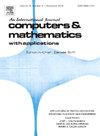点心块耦合有限体积方法的小应变静态弹塑性性能
IF 2.5
2区 数学
Q1 MATHEMATICS, APPLIED
引用次数: 0
摘要
本文评估了基于牛顿-拉夫森算法的以顶点为中心的块耦合有限体积方法的静态小应变弹塑性性能。在准静态问题的求解精度、效率和鲁棒性方面,将所提出的耦合求解方法与以顶点为中心和以细胞为中心的分离求解方法进行了比较。然后在四个测试用例上验证了这种耦合方法:一个补丁测试以检查其重现一阶多项式的能力;用人工解法检验位移和应力的收敛顺序;在弹塑性条件下对二维穿孔板和三维窄t形构件进行了分析,以检验非平凡试验用例上解的准确性。所提出的方法具有较高的准确性,计算效率比标准的以细胞为中心的分离方法提高了28倍。本文章由计算机程序翻译,如有差异,请以英文原文为准。
Performance of a vertex-centred block-coupled finite volume methodology for small-strain static elastoplasticity
This article assesses the performance of a vertex-centred block-coupled finite volume methodology for static small-strain elastoplasticity based on a Newton-Raphson algorithm. The proposed coupled solution algorithm is compared with vertex-centred and cell-centred segregated solution procedures in terms of accuracy, efficiency and robustness for quasi-static problems. This coupled methodology is then verified on four test cases: a patch test to check its ability to reproduce first-order polynomials; the method of manufactured solutions to check the order of convergence of displacement and stress; a 2-D perforated plate and a 3-D narrow T-member under elastoplastic conditions to examine the accuracy of the solutions on non-trivial test cases. The proposed methodology demonstrates high accuracy and a computational efficiency of up to 28× speedups over the standard cell-centred segregated approach.
求助全文
通过发布文献求助,成功后即可免费获取论文全文。
去求助
来源期刊

Computers & Mathematics with Applications
工程技术-计算机:跨学科应用
CiteScore
5.10
自引率
10.30%
发文量
396
审稿时长
9.9 weeks
期刊介绍:
Computers & Mathematics with Applications provides a medium of exchange for those engaged in fields contributing to building successful simulations for science and engineering using Partial Differential Equations (PDEs).
 求助内容:
求助内容: 应助结果提醒方式:
应助结果提醒方式:


